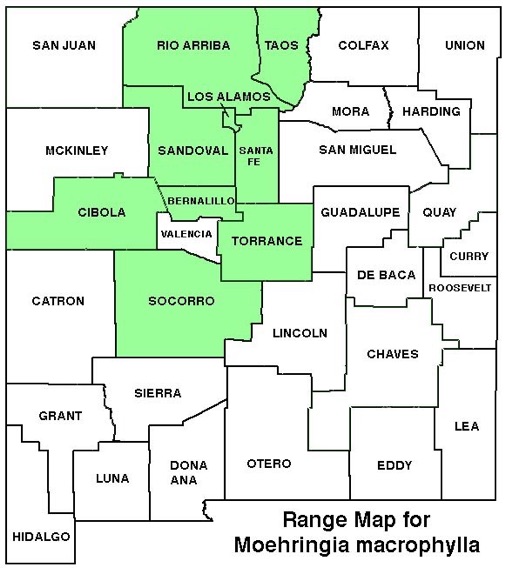WILDFLOWERS OF NEW MEXICO

Spreading by rhizomes, this delicate plant with branching, 2–8 inch tall stems can form understory colonies in mountain forests. Note the more-or-less evenly-spaced opposite leaves, and the small, white flowers in open, short-branching clusters. Occurs in NM in the Manzano, Sandia, and Sangre de Cristo mountains. Also called Big-leaf Sandwort.
FLOWER: May–July. Flowers 1/4–1/2 inch wide (6–12 mm) with 5 white, rounded petals 1/8–1/4 inch long (3–6 mm); sepals pointed, 1/2 to almost as long as petals; 10 stamens, 3 styles; clusters have 1–5 flowers on short branches.
LEAVES: Opposite, evenly spaced on stem. Blades lance-shaped to elliptical, 5/8–2 inches long (15–50 mm), 1–3 veined; surfaces smooth, margins entire, tips pointed.
HABITAT: Moist, shaded to dry, rocky to loamy soils of forest understory, riparian zones, canyon bottoms, ridges, slopes; ponderosa pine-Gambel oak–Douglas fir, mixed-conifer, spruce-fir forests.
ELEVATION: 7,300–10,500 feet.
RANGE: CA, CO, ID, MT, NM, OR, WA; a rare, endangered glacial relic in CT, MA, MI, MN, VT, WI.
SIMILAR SPECIES: Blunt-leaf Starwort, Moehringia lateriflora, in the Sangre de Cristo Mountains, has blunt-tipped leaves, and blunt-tipped sepals 1/2 or less as long as the petals. Tubular Starwort, Pseudostellaria jamesiana, in much the same range, has petals with notched tips.
NM COUNTIES: NM central mountains in mid- to high-elevation, moist habitats: Bernalillo, Cibola, Los Alamos, Rio Arriba, Sandoval, Santa Fe, Socorro, Taos, Torrance.









LARGE-LEAF SANDWORT
MOEHRINGIA MACROPHYLLA
Pink Family, Caryophyllaceae
Perennial herb









THE CONTENTS OF THIS WEBSITE ARE COPYRIGHTED AND CANNOT BE USED
WITHOUT PERMISSION OF GEORGE OXFORD MILLER
















EMAIL ME



























Large-leaf Sandwort spreads by rhizomes and can form colonies in the forest understory.
Sepals are pointed and 1/2 to nearly as long as the petals (arrow).

Leaves are lance-shaped and pointed, and opposite and evenly-spaced on the stem.
















